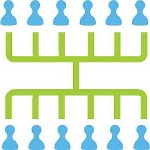
The objective of developing an organization chart for a project is to make a detailed and careful record of the activities relating to project staff deployment. An organizational chart outlines the people whose involvement in the project is necessary to success. It is a document that visualizes which roles and responsibilities which team members will carry out throughout the project course.
A project organization chart usually depicts different management functions and duties assigned to project staff and also how the team members will interrelate with each other over the course of project lifecycle and during every process stage as well. It graphically represents roles and responsibilities as boxes linked to individual team members, along with lines that show which authority and decision making power every team member has.
A project organization chart intends to:
- Identify team roles and responsibilities
- Provide a detailed picture of individuals selected for the project to perform the roles and responsibilities
- Identify training opportunities that enable the team to fulfill their duties
- Allocate resources in a proper way
- Represent appropriately all stakeholder groups involved
6 Steps to Developing an Organization Chart
Here are five steps you can take to create an organizational chart for your project. Please note that these steps are general and do not discover more specific practices and methods of project organization.
Step 1. Identify Key Personnel
The very first step is to determine business areas that directly relate to the project’s scope. Then people involved in those areas will have a direct impact on the project, and so they can be selected as key staff.
For example, when you are going to run a market research campaign most likely your project will interrelate with such areas as Marketing, Sales, Consulting, Management, others. These people will be involved in your project:
- Marketers who will directly participate in gathering and analysis of research data
- Salespeople and reps who create and provide statistics regarding sales
- Department heads who lead, control and coordinate the personnel
- IT staff who will provide technical support and assistance
- Consultants and experts who can provide valued advice and data for your research
- Other people (support staff, operations teams, on-site employees, freelancers, etc.) who may be involved or have an interest in your project
Step 2. Assemble a Senior Management Team
Next, it is necessary to recruit people who will be responsible for the project and gain management commitments. Those people should have a significant interest in project success and be committed to obtaining expected outcomes at project completion.
The following roles can be allocated to the senior management team:
- Sponsor, who owns the project, provides necessary funds and ensures right strategic direction and governance
- Client, who ensures alignment with bushiness needs
- Experts, who provide assistance and expert advice
Step 3. Assign Project Coordinators
When the team is recruited and the seniors are assembled, now it is needed to assign a person or several individuals who will take care of project performance at middle and sometimes low management levels. Coordinators will carry out those duties.
A project coordinator is a management role that embraces the responsibilities for synchronizing and integrating team activities, duties and tasks. Such a role intends to ensure that the team works towards achieving the specified goals and with expected performance.
There can be one or more coordinators in a project depending on the project’s size, complexity and structure. Often coordinators are regarded as stage leaders who take care of team performance at stage level. They focus on three main areas of a project, such as Planning, Technical, and Communications.
Step 4. Identify Key Stakeholders
Now it is time to recruit people who do not belong to the team, coordinators and senior managers but who will be affected by the project. Those people are key stakeholders who aren’t primary decision makers but who contribute to project development.
Here’re a few tips on finding key stakeholders:
- Identify who could slow down project performance if there’re some issues relating to implementation approach or financing
- Recognize people who might assist the senior management team in evaluating scope, methodology, feasibility, etc.
- Search for individuals who do not belong to the senior managers but who make an impact on the client area
- Figure out who might be affected by the project or its separate processes and stages
Step 5. Establish Training Requirements
Once the team is assembled, the project coordinator in cooperation with team leaders needs to assess the capabilities and skills of every team member. The purpose is to determine what training needs should be met and what training opportunities are open to the team.
The coordinator develops and uses assessment criteria to identify current level of knowledge and experience of the team. Next, that person explores opportunities that can be exploited to train the team. Then the coordinator creates a training plan based upon the opportunities and requirements and specifying selected methods, practices and technologies of team training.
Step 6. Develop an Organizational Chart
The final step is to review all the roles, responsibilities and people involved in the project and to create a visual representation of how individuals will collaborate with each other and how their duties will be interrelated.
When developing an organizational chart for your project, be sure that:
- Primary decision makers and their authorities are identified
- Every individual is assigned to an appropriate role
- Every role specifies a range of respective duties and responsibilities
- Links between roles are identified
- All major stakeholder groups are appropriately represented
- Reporting and communication channels are defined and described